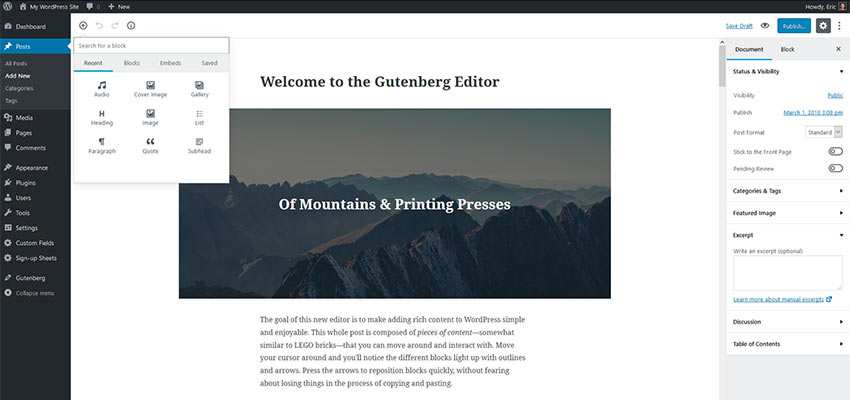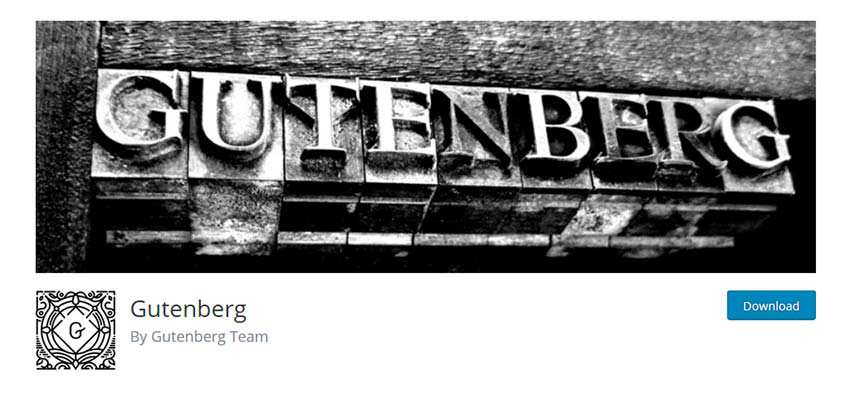Part of being a successful web designer is taking advantage of new opportunities. Some we have to hunt for, while others sort of fall into our laps. With the new Gutenberg editor for WordPress, due to be released as part of WordPress 5.0, we find one of those golden opportunities coming our way (although, some may see it more like an oncoming freight train).
This is a big change in how content is created and managed. And with an enormous user base about to be affected, there is going to be a need for experts to step in and help out. While we’re at it, we might as well make a little cash as well. Let’s look at some Gutenberg-centric ways to boost your revenue.
Train Clients in the Ways of Gutenberg
While web professionals are quite aware of Gutenberg, many of the average WordPress users out there are not. It’s safe to say that these folks are in for a bit of culture shock once they lay eyes on this very different way of doing things. This is where you come in to be that knight in shining armor.
Offer to train your clients either individually or as a group. It could be done through a webinar or in person. Show them the basics of what Gutenberg can do and how they can leverage it to improve their content. They’ll benefit from the knowledge and should be much less nervous about the change. Depending upon how in-depth you go, this could provide you with a means to make some money as you help.

Test Existing Sites for Compatibility
There is concern that certain themes or plugins may not play nicely with Gutenberg. And, although efforts are being made to ensure backwards compatibility, there are no guarantees. Heavily customized sites would seem especially vulnerable to suffering from an unexpected issue or ten.
The only way to know if something’s going to work is to test it out. Since Gutenberg is available as a plugin for the time being, there’s an avenue for testing until WordPress 5.0 release candidates become available.
Testing takes time, though. A staging site would have to be installed locally or on a separate bit of hosting space. From there, you have to make sure everything runs the way it is supposed to – and that’s before Gutenberg is installed. You then have the privilege of installing the editor and thoroughly testing out the site. Lastly, you have to identify and (hopefully) fix any bugs that you find.
Providing this service may drive you crazy, but it can also result in some extra cash.

Retrofit Older Themes
Any website running a pre-Gutenberg theme may not be able to fully take advantage of everything the new editor has to offer. While just about every included content block should work with any theme, there may be a need to tweak styling. For instance, there is a “Cover Image” block included that allows for full-width images. However, not every theme is set up to support images of that width.
That presents an opportunity for developers. While you’re educating clients about the benefits of block-based content creation, you might want to offer to ensure that their theme can handle everything Gutenberg will throw at it.
Even if you’re not an expert with regards to how to tweak themes for Gutenberg just yet, there’s plenty of help out there. The official handbook is a great place to start.
Create Custom Blocks for Clients
One of the truly cool features of Gutenberg is the ability to create your own custom blocks. It provides a lot of flexibility in terms of what you can do. For example, you may want to create a block that allows for multi-column layouts or one that includes site-specific styles. You can really use your creativity to produce blocks that solve problems.
When working with a client on a new site, building custom blocks for them could allow you to raise prices accordingly. It’s another way to make content management easier for clients. Convenience adds value, after all.
If you’re looking for some help in creating custom blocks, check out the Gutenberg Boilerplate. It will walk you through a few examples and help to get you off the ground in building your own solutions.

Be a Source for Support
Let’s face it: When a client has a problem, they’re most likely going to come to you. Therefore, you will become a source of support for their Gutenberg-related issues whether you like it or not. It’s just part of our job.
But there is some money in it, depending upon the type of arrangements you have with your clients. If you charge hourly for support or sell support packages, you have an opportunity to bring in some more revenue.
There are sure to be a plethora of issues and questions that arrive in your inbox. The bright side is that you might make enough money to pay for some exercise classes or enough adult beverages to counteract the stress of providing support.

Change Brings Opportunity
Web design is constantly evolving. So often, the changes we see in the industry are related to some great new JavaScript framework or a new way to create layouts in CSS. They tend to directly impact designers more than clients.
But what’s unique about the arrival of Gutenberg is that it is something that affects users just as much as designers. And, when a change is this significant, there’s really no way to avoid it. It puts a lot of responsibility on us, but it also provides an opportunity to increase business. In that way, Gutenberg may make your 2018 a prosperous one.
Related Topics
Top